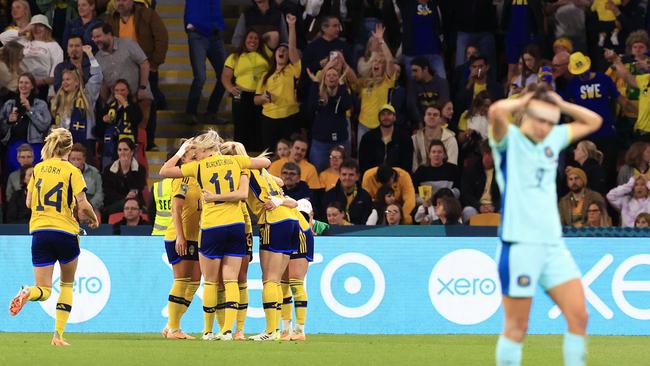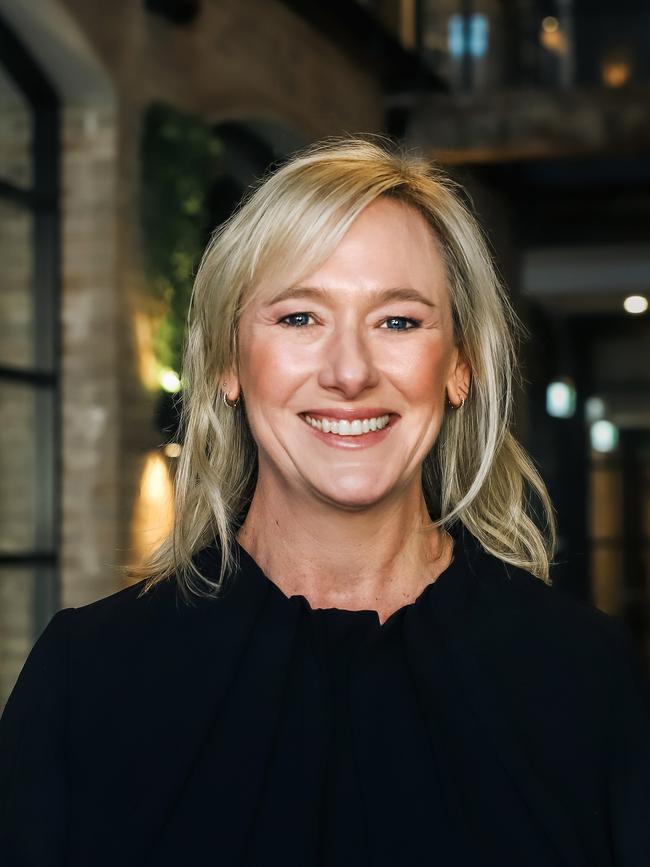Lesson from the Matildas’ popularity is the power of marketing
Record TV audience and attendance numbers at FIFA Women’s World Cup have shone a bright spotlight on the sport – and the brands that have put their name to the tournament.

The business of sports marketing has come into sharp focus in recent weeks, as the momentum and support for FIFA: Women’s World Cup and the story of the Matildas has become embedded in culture, commerce and conversations across the country and around the world. The Growth Agenda asked marketing leaders, experts and one of the tournament’s sponsors, accounting software company Xero, to explain what’s in it for brands and audiences.
Krystyna Frassetto, managing director of M&C Saatchi Sport Entertainment
Women’s football has won the hearts and minds of Australians in a way most couldn’t have anticipated a month ago let alone a year ago. It might feel like an overnight success to some, but that’s underselling it. It’s the culmination of a brilliantly executed strategy from Football Australia and years of effort from players, fans and partners who have been backing women’s football, and football generally, well before the tournament kicked off.

You could say the last two weeks of Matilda-mania is thanks to Australia’s unparalleled passion for sport, and our love for an underdog story that is well-documented. It also helps that the Women’s World Cup has been on our home turf, on prime time, free-to-air TV. But it’s more than that.
The Matildas have united the country with a common focus and sense of national pride that we’ve all desperately needed after years of increasing pressure and disconnection. Sport has always had a magical way of doing that in this country but it’s at a scale I’ve never seen before.
Behind the record-breaking viewership numbers and sell-out stadiums and merchandise of the World Cup, is a story of female empowerment. A timely narrative when women are feeling under more pressure than ever. The tournament has surfaced stories of the modern experience of being female – stories of resilience, empathy, motherhood and friendship which in turn gives other women, everyday Australians, strength and a sense of belonging.
The whole of Australia has thrown support behind the Matildas and for me, that’s a signal that Australians want to see more of these stories, and more of a spotlight on these incredibly strong, fearless women and role models for the next generation. Brands that learn from this and lean into it can tap into these communities and build meaningful connections with customers.

Dr Kevin Argus, Senior Lecturer, Design Thinking and Marketing, RMIT University
The 2023 Women’s World Cup is distinctive in that the quality of women’s soccer seen by fans and viewers across Australian and New Zealand has surpassed most people’s expectations. The men’s World Cup is the biggest sport on the planet, so the FIFA brand carries significant equity. What we now see is the product quality of women’s football is aligned with that of the men’s game. Over the past decade, we have seen the growth in women’s football in Europe where they receive professional salaries and support that is aligning with the men’s game. This tournament has transformed broader perceptions of women’s sports in Australia and New Zealand.
The growth driving opportunity for brands is to be found in looking at rising trends – using forecast data rather than looking in the rear mirror at data and statistics on participation and fan numbers at league games and community levels.
Business leaders and marketing strategists need to look at significant demographic shifts occurring globally, reflected in the Australian market. The rising influence of Gen Z and millennials on electoral cycles in Australia, the US, UK and other democracies with similar post WWII population trends is beginning to take effect and is forecast to have profound influence on who gets to design policy and control government resourcing over the next two decades.
Much has been written and discussed of how inclusive and safe this event feels. Gen Z have a lived experience that is more diverse, inclusive, and fair minded than earlier generations. This is reflected across the women’s teams in this competition with a record 96 women identifying as LGBTQ according to outsports.com.
FIFA may have banned the rainbow flag from flying at venues during this World Cup. However, they appear misaligned with the reality of society and who has and will increasingly influence policy – which has implications for sport organisations.
Governments and businesses are beginning to explore ways to align with the most influential generation ever, with Gen Z representing 30 per cent of the world’s population and 20 per cent locally.
It’s no surprise that governments of all levels have come to the party and offered venues free of charge so that fans can have an immersive collective experience watching the Matilda’s on a big screen. By the next Women’s World Cup the state of women’s soccer in Australia will be vastly different, as will the policy settings of governments and organisations, as influenced by a wave of enthusiasm among young people for designing an inclusive, fairer, and diverse society. The opportunity for brands to leverage this purpose to action and build equity is enormous and largely untapped.

James Kyd, executive general manager of brand and marketing at Xero
We’ve seen record attendance at matches, record broadcast audiences, and social media is buzzing. Billions of people globally are watching and engaging which is a great opportunity for brands to build awareness and connection to new global audiences. That being said, the brands that will benefit most are those that thoughtfully engage with the event and connect with audiences, understanding how it is different and the potential that brings.
We also believe it provides an opportunity to demonstrate Xero’s values and we’re proud to be an organisation that champions gender equality and celebrates diversity in all its forms.
So, along with the brand awareness, we’re applying our technology and expertise to drive commercial success in women’s football and the prospect for better outcomes for women globally as well as the many small businesses and communities that support women’s football around the world.
We’re also providing free education and financial literacy tools as part of our long term partnership with FIFA and other clubs around the world to help drive commercial success in women’s football and better outcomes for those communities who support it. When women’s clubs thrive, teams thrive, communities thrive and small businesses that support those communities thrive.

Peter Filopoulos, head of marketing, communications and corporate affairs, Football Australia
The 2023 FIFA Women’s World Cup Australia & New Zealand is not just another tournament – it’s a celebration of the indomitable spirit of women in sports. The remarkable success of the group stage this year can be attributed to several factors. Firstly, the efforts of Football Australia in deliberately investing in elevating the CommBank Matildas to equal status with the Subway Socceroos and authentically promoting women’s football in the community, have proven that, when women are given an equal platform, they shine brilliantly.
When bidding to secure the hosting rights for the FIFA Women’s World Cup, Football Australia understood that bringing this tournament to our shores would be a transformative moment for not only women’s football, not only for football, but for sport in Australia. Leading into the FIFA Women’s World Cup, Football Australia invested significantly in deep brand strategies, clever marketing campaigns, authentic content and engagement strategies to ever-growing targeted audiences which was rewarded with increased broadcast audiences on free to air with Network 10, record attendances at matches, merchandise sales and enormous digital reach. We ensured that we exposed the Matildas to most markets throughout Australia when selecting venues and cities for international matches and worked with Disney to produce a documentary “The World at Our Feet” so that all Australians can fall in love with the players that make up the CommBank Matildas by getting behind the scenes.
For brands, this marketing moment is golden. The excitement surrounding the FIFA Women’s World Cup offers a unique confluence of emotion, passion, and unity. Brands have the opportunity to tap into a movement that is larger than the sport itself. It’s about celebrating women’s achievements, supporting equality, and fostering a sense of community. When brands align themselves with such powerful narratives, they not only drive growth but also create meaningful connections with their audience. The Legacy ’23 plan by Football Australia further underlines the promise of long-term positive impacts, from economic to health benefits. This presents brands with a unique chance to be part of a legacy, resonating with values and stories that will be told for generations. Embracing this marketing moment means championing a cause, celebrating the beautiful game, and making a difference on a global stage.

Suzie Shaw, chief executive, We Are Social Australia
Many of the players are true social (media) natives, helping fans get to know them, building authentic profiles and driving relatability and aspiration. In general, audiences respond to human stories and the Matildas’ intimate approach to sharing their own journey through the tournament has really helped to capture the hearts and minds of all Australians.
Interestingly, a trend we see across many sporting codes is that players tend to have larger and more engaged audiences than clubs and codes themselves, demonstrated by Sam Kerr’s now 2 million combined social following, which is more than double the Matildas’. The lesson here is clear, people connect more with people than brands or corporations, and this underscores the crucial role human storytelling plays in fostering those meaningful connections.
Additionally, we’re obviously a very multicultural nation and this month-long global tournament has given many fans entry points to get behind the team of their heritage.
Throughout the tournament, we’ve seen record-breaking numbers tuning into games, as well as engaging in post-game analysis and conversation, meaning it’s delivered a large and diverse audience for marketers to engage at scale.
It’s also about the opportunity for meaningful connection, by leveraging a collective viewing experience. With an increasingly fragmented media landscape and much of the content we consume not being linear (due to the popularity of subscription video-on-demand viewing), there are limited opportunities to engage audiences in simultaneous viewing experiences, yet the FIFA Women’s World Cup’s momentum has been fuelled by one critical factor – the game’s ability to act as a conversation piece between friends, or online. The game is an opportunity to connect. The conversations we have about it are more important to us than the game itself and the lesson here for marketers is to give people context for conversations about their brand, by leveraging a shared passion and experience.
This is where culture emerges as a multiplier. If brands can tap into the cultural zeitgeist, as Orange France did with their impactful stance on gender parity, they provide their audience with a platform for meaningful conversation, as well as seize an opportunity to make powerful statements about the brand’s values. In essence, this marketing moment isn’t just about promoting brands; it’s about cultivating shared experiences and sparking conversations that resonate deeply within the hearts of the audience.





